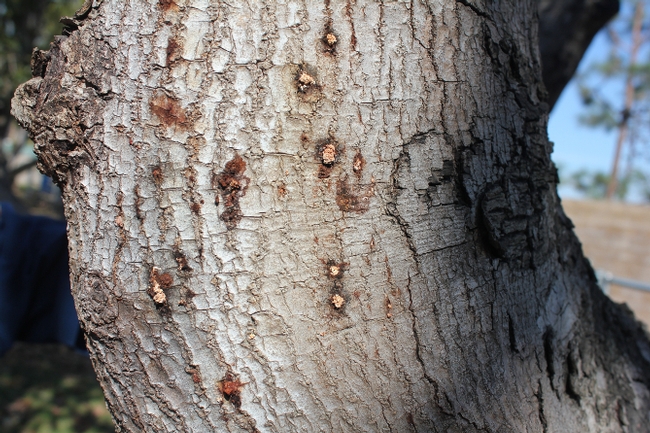
Posts Tagged: shot hole borer
Beetle:Fungus Symbiosis?
Origin and evolution of fungus farming in wood-boring Coleoptera – a palaeontological perspective
David Peris, Xavier Delclòs, Bjarte Jordal https://doi.org/10.1111/brv.12763
A beetle bores a tree trunk to build a gallery in the wood in order to protect its lay. As it digs the tunnel, it spreads ambrosia fungal spores that will feed the larvae. When these bore another tree, the adult beetles will be the transmission vectors of the fungal spores in another habitat. This mutualism among insects and ambrosia fungi could be more than 100 years old --more than what was thought to date-- according to an article published in the journal Biological Reviews.
The study analyses for the first time the symbiotic associations and the coevolution between ambrosia fungi and beetles from a paleontological perspective using the Cretaceous fossil records of these biological groups. Among the authors of the study are the experts David Peris and Xavier Delclòs, from the Faculty of Earth Sciences and the Biodiversity Research Institute of the University of Barcelona (IRBio), and Bjarte Jordal, from the University of Bergen (Norway).
Beetles that grew fungi millions of years before human agriculture
Some termites, ants and beetles developed the ability to grow fungi in order to eat millions of years ago. This mutualism between insects and fungi --one of the top studied symbiosis in the natural field-- is an analogous evolutionary strategy in the farming activities of the human species since the Neolithic revolution.
Understanding the origins of the symbiosis between insects and fungi is a field of interest in several scientific disciplines. Nowadays, the mutualism between ambrosia symbiont beetles and fungi is the cause of forest and crop plagues that cause serious ecological and economic losses "it remains unclear which ecological factors facilitated the origin of fungus farming and how it transformed into a symbiotic relationship with obligate dependency", notes David Peris, first author of the study.
When did the lineage of farming insects begin?
Historically, phylogenetic studies suggest beetle fungiculture started more than 50 million years ago --before other insects-- and some studies dated it back to 86 million years ago. "The symbiotic relationship between fungus and beetles would have probably originated more than 100 million years ago, during the early Cretaceous, in groups of beetles that had gone unnoticed", reveals the expert David Peris.
As part of the study, the experts studied several specimens of worldwide distribution of the biological groups captured in amber from the Cretaceous. Therefore, the origin of ambrosia fungus is older than the main groups of beetles from the subfamilies Scolytinae and Platypodinae --Curculionidae family-- which now grow fungus in tree trunks, as stated by the authors.
"This suggests that these fungi used some other group of insects to spread millions of years ago", notes the researcher. Also, other beetle groups with a similar behaviour to ambrosia beetles --Bostrichidae and mostly Lymexylidae families-- present an older and abundant fossil record that would coincide with the emergence of ambrosia fungi, according to previous studies.
"The most interesting thing --he continues-- is that some studies note the ability to cultivate fungi in some of these current species".
Evolutionary convergence towards an obligate mutualism
The growing process of fungi starts when beetles colonize a new tree trunk or branch. During the Cretaceous, the abundance of fungi and wood-boring beetles facilitated a starting domestication of some groups of fungi. First, the fungal spores were accidentally transported from tree to tree by the wood-boring beetles "until this mutually beneficial association evolved towards a more intimate symbiosis in which fungi were inoculated into to a tree, the fungal mycelia grew and beetle larvae fed from the fungus", notes Bjarte Jordal.
This set of factors, together with the symbionts' high ability to adapt and change, eased the morphological and ecological adaptations of biological groups that converged in an obligated mutualism. That is, a symbiotic relationship between insects and fungi, beneficial for both, which still lasts.
"However, we need more studies on the knowledge of the ecology of the species from the Lymexylidae and Bostrichidae families to get more specific conclusions. Therefore, the discovery of new fossils in cretaceous amber of these groups will certainly help us to better understand the evolutionary history of this symbiotic relationship that still exists nowadays", concludes Professor Xavier Delclòs.
Read on: https://onlinelibrary.wiley.com/doi/full/10.1111/brv.12763
Photo: Invasive Shot Hole Borer tunnels in Box Elder trunk
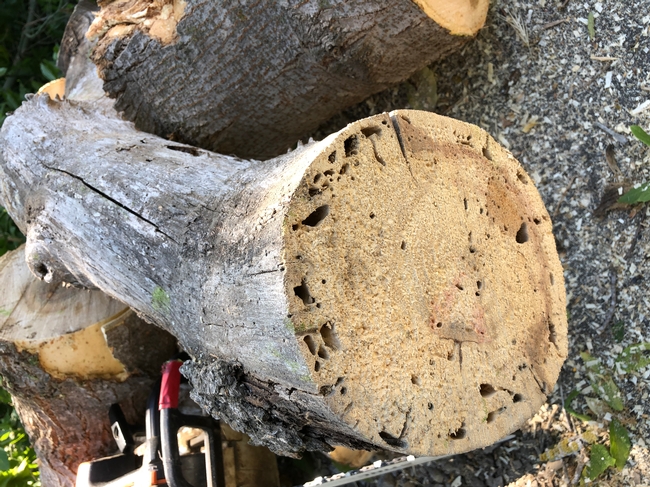
shot hole borer feeding
What Happened in the Tijuana River?
from Dr. John Boland, Dr. Kellie Uyeda researchers, Dr. Jeff Crooks, advisor, Monica Almeida, cartography, Mayda Winter, project management
The Kuroshio Shot Hole Borer (KSHB) is a tiny beetle that invaded San Diego County in 2013. It was first seen in some avocado groves but then in 2015, it became very abundant in the native riparian forests in the Tijuana River Valley. It immediately caused extensive damage to those forests and as it is now also being found in many other sites in southern California, the authorities are extremely concerned that other sites are going to be impacted as badly as the Tijuana River Valley.
Luckily Dr. John Boland was studying the willow trees in the valley in 2015 and he immediately switched his focus to the KSHB's impact in the valley. Here we present a summary of the four main storylines coming out of his intensive five-year study of the beetles in the valley: the KSHB in the valley went through a 5-year boom-and-bust cycle; the KSHB severely damaged the native willow forests in the valley but the forests are now rapidly recovering; the research has uncovered two mysteries about the KSHB – one we think is solved and the other still needs to be solved; and the research has led to a prediction about KSHB's likely impact at other sites in southern California and several management recommendations.
When KSHB (Euwallacea kuroshio) attack a tree, the females drill into the trunk and create galleries of tunnels in the wood by pushing sawdust ‘tailings' out of the entrance hole. They inoculate the tunnel walls with a fungus (e.g., Fusarium sp.), and live in the tunnels eating the fungus and reproducing. Within a few weeks new females emerge, and start another gallery in either the natal tree or a new tree.
The beetles are tiny (~2 mm in length) and seldom seen, however if there are enough of them they can damage and even kill trees via their tunneling activities, which undermine the structure of the tree trunks.
The Tijuana River Valley and the riparian forest
The Tijuana River Valley in San Diego County, California, is a coastal floodplain of approximately 3,700 acres at the end of a 1,730 square mile watershed. The Tijuana River is an intermittent stream that typically flows strongly in winter and spring and is mostly dry in summer. For decades, the Tijuana River has been polluted with sewage and industrial waste as it flowed through the city of Tijuana, Mexico, and when it flows through the Tijuana River Valley it is one of the most polluted rivers in California.
The riparian forest that grows around this river is one of the largest in coastal southern California. The forest is dominated by just two tree species: the black willow (Salix gooddingii) and the arroyo willow (Salix lasiolepis). Both willow species are high on the list of KSHB's preferred hosts.
Annual surveys of infestation rates showed that the KSHB population went through a rapid outbreak and a rapid decline over a five-year period, with the infestation rates peaking in Fall 2016. The early increase in population occurred while the KSHB was attacking the willows in the Wet Forests and the later decrease in population occurred while the KSHB was attacking the willows in the Dry Forests.
The KSHB boom-and-bust is now complete. In fall 2019 it was difficult to find any trees infested with KSHB. While it lasted the KSHB's population explosion was very destructive: it has been estimated that the KSHB infested more than 375,000 willows and killed more than 122,000 willows in the valley.
This boom-and-bust cycle occurred naturally, with no management interventions to control the spread or severity of the outbreak.
Satellite image analyses conducted by Dr. Kellie Uyeda determined spatial and temporal patterns of canopy loss. The normalized difference vegetation index (NDVI), a metric of vegetation health, was calculated for each year from 2015 - 2019.
The remote sensing analyses support the results seen in the ground surveys. First, in the early years of the KSHB infestation, the most dramatic vegetation losses were observed in the Wet Forests and in later years the vegetation losses were observed in the Dry Forests, with lower levels of vegetation loss. Second, the KSHB's impact was greatest in 2016-17 and since then it has been tapering off.
Seedlings
After the KSHB had damaged the adult willows many willow seedlings recruited onto the sunny and moist river beds. Most of the willow seedlings were scattered within the forest, but three large stands of seedlings became established in three units.
A few old willows survived the KSHB invasion and remain as scattered Big Trees. It is likely that they will play an important role in the recovery of willows in the river valley.
Fortunately, the heavily-damaged Wet Forest units recovered considerably, and in some places the forests are almost back to their pre-KSHB condition. However, in other places they have failed to return because of the expansion of the invasive plant arundo, Arundo donax.
We think we know the answer to this mystery:
We think it has to do with the sewage pollution in the river. Sewage contains the most important plant nutrients (nitrogen, phosphorus and potassium) in abundance and so the willows growing in or near the polluted channel water were growing vigorously. The KSHB targeted these fast-growing willows because the sap in these trees was being nutrient loaded in two ways – phloem sap was loaded with sugars from the fast-growing leaves, and xylem sap was loaded with nutrients from the enriched soil. These extremely high nutrient conditions in the wood allowed for the fast growth of the KSHB's symbiotic fungi and ideal conditions for the rapid population growth of the KSHB (the Enriched Tree Hypothesis).
Some kind of link between the environment and shot hole borer impact had been suspected but not previously identified. Hulcr and Stelinski (2017) noted that “in ambrosia beetle research, the role of the environment and preexisting conditions of the trees has not yet been well appreciated, even though it appears to determine the impact of these beetles.” The Enriched Tree Hypothesis directly links the environment (enriched water) and the preexisting condition of the trees (vigorous, fast growing willows) with the impact of the KSHB (tens of thousands of KSHB per host tree, which cause the trunk to snap and the canopy to collapse).
Why are the recovering willows not being re-attacked by the KSHB? The recovering willows in the Wet Forests are forming forests similar to what was present before the KSHB invasion, but the trees are not being substantially re-attacked by the KSHB. Why?
We don't know the answer but suggest these three possibilities: An ‘induced response' of the trees. It is possible that the infested willows have changed their chemistry as a result of the borer attack, and this has increased the resistance of the surviving trees to further borer attacks; overall forest structure. It is possible that the willows, though individually suitable, no longer present a suitable group target for the KSHB; and a disease or predator. It is possible that the KSHB population in the valley is now being kept low by a pathogen, parasite, parasitoid or predator. It will take further research to solve this mystery. But understanding it will provide essential information about the KSHB invasion in southern California and about shot hole borers in general.
Why was the KSHB's impact different in different parts of the valley? The distribution of KSHB within the Tijuana River Valley was not random; they infested and killed willows growing in or near the main channel significantly more than willows growing far from the water. On the wet site the mortality rate was high, and on the dry site the mortality rate was low. Black willow was the most abundant tree species in both sites. Why the difference?
We think we know the answer to this mystery: We think it has to do with the sewage pollution in the river. Sewage contains the most important plant nutrients (nitrogen, phosphorus and potassium) in abundance and so the willows growing in or near the polluted channel water were growing vigorously. The KSHB targeted these fast-growing willows because the sap in these trees was being nutrient loaded in two ways – phloem sap was loaded with sugars from the fast-growing leaves, and xylem sap was loaded with nutrients from the enriched soil. These extremely high nutrient conditions in the wood allowed for the fast growth of the KSHB's symbiotic fungi and ideal conditions for the rapid population growth of the KSHB (the Enriched Tree Hypothesis).
Some kind of link between the environment and shot hole borer impact had been suspected but not previously identified. Hulcr and Stelinski (2017) noted that “in ambrosia beetle research, the role of the environment and preexisting conditions of the trees has not yet been well appreciated, even though it appears to determine the impact of these beetles.” The Enriched Tree Hypothesis directly links the environment (enriched water) and the preexisting condition of the trees (vigorous, fast growing willows) with the impact of the KSHB (tens of thousands of KSHB per host tree, which cause the trunk to snap and the canopy to collapse).
Management recommendations
Do not cut down and remove infested trees thinking that they are going to die. Willows can survive very heavy infestation rates. Remove Arundo in order to improve the riparian forests in the valley. Arundo is degrading the forests and needs to be removed for the willows to fully recover. Continue to plant willows in restoration sites. Use ‘natural restoration' methods wherever you can. When searching for KSHB in other parts of San Diego County search in nutrient-enriched areas, e.g., near storm drain outfalls. In urban forests do not over-fertilize or over-water trees. Nutrient-enriched and fast-growing trees are more vulnerable to KSHB infestation.
This research was funded by the Department of Navy on behalf of the Naval Base Coronado. Funds were managed by the Southwest Wetlands Interpretive Association.
The reports and some of the data analyses were done in collaboration with the Tijuana River National Estuarine Research Reserve.
And Read More: https://trnerr.org/kshb/
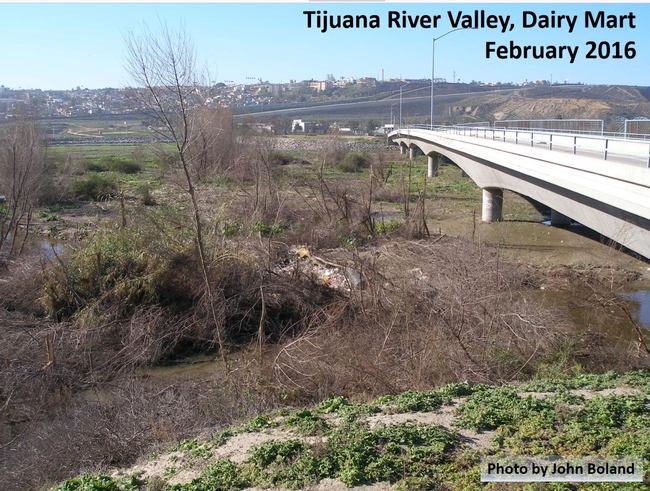
Tijuana willows shot hole
Essential Read:
Invasive shot hole borers (ISHB) are tiny beetles that are posing a significant threat in Ventura County and beyond.
There's new information provided in this blog post by Wayne Farnsworth of BrightView Tree Care Services and Randall Oliver, UC ANR Integrated Pest Management Program. It appeared on the Channel Islands Chapter of the Community Association Institute website.
These pests are becoming established in parts of Ventura County. Farnsworth and Oliver note that "Unlike many insect pests, invasive shot hole borers infest a wide variety of tree species, including many common ornamentals, avocados and California natives. Sycamores and box elders are among their favorites, and they also attack live oaks, valley oaks and alders, all of which are abundant in our area."
Per UC ANR, invasive shot hole borers are
"two closely related species of small, non-native, beetles that bore into trees. ISHB introduce fungi that cause a tree disease called Fusarium dieback (FD). The ISHB-FD pest-disease complex is responsible for the death of thousands of trees in Southern California and poses an imminent threat to the integrity of our urban and natural forests.
Invasive shot hole borers attack a wide variety of tree species including avocados, common landscape selections, and California native species in urban and wildland environments."
You can learn more about ISHB at the UC ANR Integrated Pest Management website.
As Julie Di Blasio reported last year, "...invasive shot hole borer (ISHB) infestations have been identified in Ventura County since 2015 but have not significantly spread. Discovery of the pest/disease complex was found in late 2018 in the urban forest of Meiners Oaks. Citizens Journal recently published an article about the removal of a tree that was at risk for amplifying the local infestation and causing potential other community harm."
UCCE Ventura has been collaborating to address ISHB with UC insect, disease, education specialists, Ventura County Agricultural Commissioner, CAL FIRE, US Forest Service, several other agencies and non-government organizations. We are locally active in monitoring and outreach. Ventura County Master Gardeners Invasive Pests Outreach Group augments our work through their efforts to educate the public, firewood users and vendors."
Image credit: Akif Eskalen, UC Davis/UC ANR
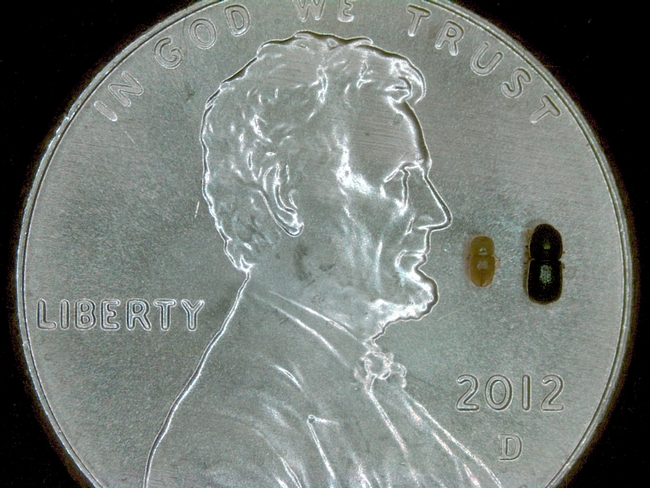
Invasive shot hole borer on coin - Akif Eskalen
Invasive Shot Hole Borer Discussed in Article
Invasive shot hole borer (ISHB) infestations have been identified in Ventura County since 2015 but have not significantly spread. Discovery of the pest/disease complex was found in late 2018 in the urban forest of Meiners Oaks. Citizens Journal recently published an article about the removal of a tree that was at risk for amplifying the local infestation and causing potential other community harm.
The Ventura Agricultural Commissioner supervised the removal of the tree, using grant funds for this purpose from CAL FIRE. The box elder was located on private property and considered to be a hazard to extend the infestation.
UCCE Ventura has been collaborating to address ISHB with UC insect, disease, education specialists, Ventura County Agricultural Commissioner, CAL FIRE, US Forest Service, several other agencies and non-government organizations. We are locally active in monitoring and outreach. Ventura County Master Gardeners Invasive Pests Outreach Group augments our work through their efforts to educate the public, firewood users and vendors.
Below is a video produced by California Releaf, a nonprofit organization that works to empower grassroots efforts and build strategic partnerships that preserve, protect, and enhance California's urban and community forests. It's been edited for length.
For more information about ISHB, you can also visit the UCANR website.
Shot Hole Borer in Avocado - Webinar
What Are the UC Ag Experts Talking About?
Invasive shot hole borers in avocado
May 20, 2020, Wednesday, 3-4 PM
Upcoming topics:
- Vertebrate pests by Roger Baldwin (June 2020)
- Ants in citrus by Mark Hoddle (July 2020)
- Use of plant growth regulators on citrus by Ashraf El-kereamy (August 2020)
Check out previous talks and listen to their recordings
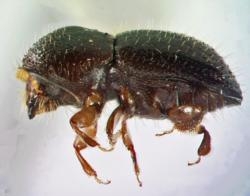
shot hole borer

